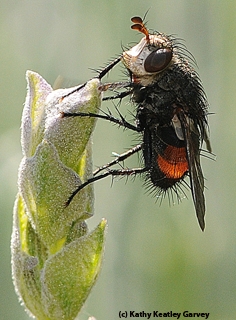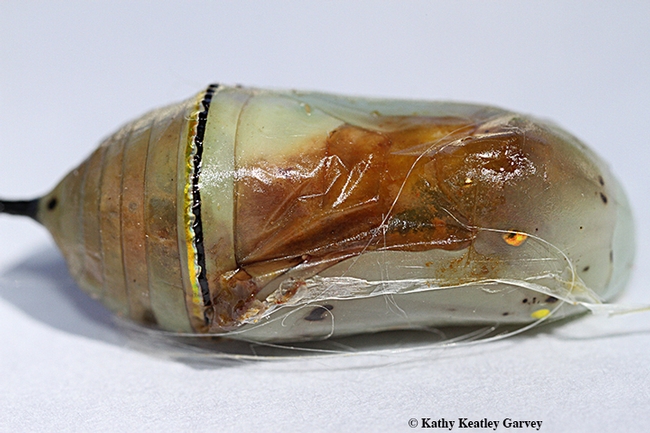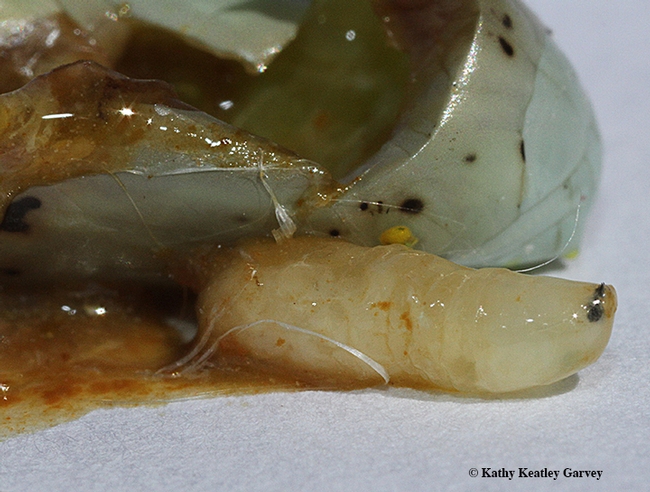
You notice an egg on your milkweed plant, and watch its life cycle from egg to caterpillar to chrysalis. Aha, you think, soon I'll be able to see an adult monarch eclose from that chrysalis.
Not so fast.
If a tachinid fly lays eggs in that caterpillar or chrysalis, you'll get several tachinid flies, not a monarch. The fly larvae will eat the host--the caterpillar or chrysalis--from the inside out.
The tachinid fly is a parasitoid, and you can learn all about this parasitoid and many others at the Bohart Museum of Entomology's open house, Parasitoid Palooza, set from 1 to 4 p.m., Saturday, Nov. 18 in Room 1124 of the Academic Surge Building, UC Davis campus. It's free and open to the public and family friendly. A family craft activity is planned.
What's a parasitoid?
"An insect parasitoid is a species whose immatures live off of an insect host, often eating it from the inside out," said Tabatha Yang, education and outreach coordinator of the Bohart Museum of Entomology. "It is part of their life cycle and the host generally dies."
Among the presentations or topics:
- Bohart Museum senior museum scientist Steve Heydon, a world authority on Pteromalids, or jewel wasps, a group of tiny parasitoids.
- Entomology PhD student Jessica Gillung who researches the Acroceridae family "a remarkable group of endoparasitoids of spiders."
- Family craft activity is a pop-up card, featuring a monarch chrysalis and a fly, suitable for mailing to friends and family during the holiday season.
There are some 3,450 described species of Pteromalids, found throughout the world and in virtually all habitats. Many are important as biological control agents.
Members of the Acroceridae are "rare and elusive flies lay the eggs on the ground or vegetation, and the little larva is in charge of finding itself a suitable host," Gillung said. "Upon finding the host, the larva enters its body and feeds inside until it's mature to come outside and pupate. They eat everything from the spider; nothing is wasted."
Her dissertation involves "the evolution and systematics of Acroceridae, focusing on understanding host usage patterns and trends in morphological variation."
Tachinid flies, which lay their eggs in caterpillars and chrysalids, will be on display, along with the remains of its hosts. It is used as a biological control agent for some pests. But those who rear monarch butterflies consider it their enemy when it lays eggs in their caterpillars and chrysalids.
The late UC Davis entomologist Richard M. Bohart (1913-2007) researched Strepsiptera, or twisted-wing parasites, for his doctorate in 1938. Both the Bohart Museum and an entire family of Strepsiptera, the Bohartillidae, are named in honor of Professor Bohart.
The Bohart Museum, directed by Lynn Kimsey, professor of entomology at UC Davis, houses a global collection of nearly eight million specimens. It is also the home of the seventh largest insect collection in North America, and the California Insect Survey, a storehouse of the insect biodiversity.
Special attractions include a “live” petting zoo, featuring Madagascar hissing cockroaches, walking sticks, praying mantids and tarantulas. Visitors are invited to hold some of the insects and photograph them. The museum's gift shop, open year around, includes T-shirts, sweatshirts, books, jewelry, posters, insect-collecting equipment and insect-themed candy.
The Bohart Museum holds special open houses throughout the academic year. Its regular hours are from 9 a.m. to noon and 1 to 5 p.m. Mondays through Thursdays. The museum is closed to the public on Fridays, Saturdays and Sundays and on major holidays. Admission is free.
More information on the Bohart Museum is available by contacting (530) 752-0493 or emailing bmuseum@ucdavis.edu or Tabatha Yang at tabyang@ucdavis.edu.
Attached Images:

